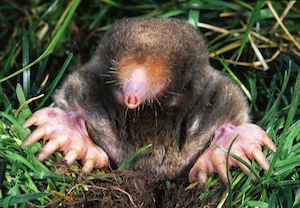A Girl and Her Mole
By Emily Belinfante, Camp Kingfisher Registrar
A few weeks ago, while driving into the Chattahoochee Nature Center, I spotted something in the road. I often play a game called “Is it a turtle?” along Willeo Road, typically resulting in “no, it’s a pinecone.” This, however, was not a pinecone. Or a turtle. I stopped, curiosity piqued, and found myself looking at a small, brown, furry mass with the largest front feet I have ever seen for something that small. Naturally – and quite professionally – I touched it. It was no longer alive, so I picked it up. Enthusiastically, I presented it to my co-workers, though I wasn’t exactly sure what it was. I’d seen pictures of moles in school, and I knew they were native to Georgia, but I had never laid eyes on a real one. A quick Google search answered a few questions, which quickly led to a deep dive down the rabbit hole – or, more aptly, the mole hole – into the underground world of Leo (everyone needs a name), the Eastern mole.
The Eastern mole (Scalopus aquaticus) is a small, secretive creature known for its incredibly powerful front feet and the hills that mark its existence to us above-ground dwellers. These subterranean architects dig out extensive tunnel networks that provide all the luxuries a mole could ask for: sleeping quarters, travel lanes, and grub buffets. A typical mole abode consists of one semi-permanent burrow dug below the frost line for long-term use, and smaller temporary tunnels near the surface that are used for hunting. Location and structural integrity are very important to a mole. Nobody wants their hard work destroyed by cave-ins, floods, or other catastrophes. The soft but sturdy earth of fields, woods, local parks, golf courses, and your lovely manicured lawn are ideal. The characteristic mole hills are simply chimneys used to transport soil out of the way as the mole cultivates and maintains its hunting grounds.
Now, if you’re thinking, “wait, moles hunt?” then you’re in good company. I had no clue my new fuzz-ball friend had been a ravenous, cunning predator in its formative… years… months? (We’ll talk about it). Those shallow tunnels are really just worm traps. When the earth gets saturated after rain, terrestrial insects are driven to drier areas like, say, the open space of a tunnel. The mole then feasts, eating up to 50% of its body weight. Daily. How much is that in a lifetime?! I did some math: an average mole lives roughly six years and weighs about 75 grams, meaning it could eat roughly 160-180 pounds of bugs in its lifetime. If there were no moles, and that many more insects, could plant life survive? Moles help balance our delicate ecosystem by keeping insect populations in check. So thanks, moles, for having an insatiable appetite.
With a better understanding of Leo’s life, I now feel confident and comfortable preserving this mole through taxidermy. Then it can live on as an educational tool, shedding light on life below ground for students and visitors for years to come.

